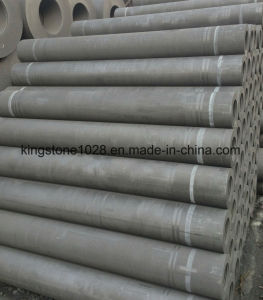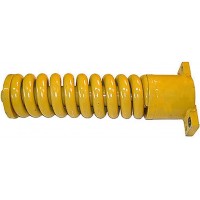-
Phone
86-731-82285428
-
Address
Rm1612, No. 158 Wu Yi Road, Changsha, Hunan, China
-
E-mail
LatestProducts

RP, HP Graphite Electrode with Nipple
China RP, HP Graphite Electrode with Nipple, Find details about China Graphite Electrode, Graphite from RP, HP Graphite Electrode with Nipple - Kingstone Industrial Group Limited
Description
Basic Info
- Model NO.: RP, HP
- Composition: Graphite
- Grade: HP
- Crystal Morphology: Compact Crystalline Graphite
- HS Code: 85451900
- Type: Graphite Electrodes
- Carbon Content: High-Carbon
- Forming Way: Extruded Graphite
- Transport Package: Pallet
Product Description
Graphite electrode is made of high quality petroleum coke and pitch. This product goes through the process of calcining, matching, blending, modeling, baking, graphitization and machining and etc before it rolls off the line. The nipple of the electrode takes the technology of three-time impregnating and four-time baking to produce.
1. Introduction:
Artificial graphite electrode is made of high-quality low ash materials, such as petroleum coke, needle coke and coal pitch. After calcining, burdening, kneading, forming, baking and pressure impregnation, it is graphitized in a high temperature of over 3000°C, and then treated with machining. Such of the products own characteristics with low resistivity, good electrical conductivity, low ash, even and compact structure, good anti oxidation and high mechanical strength.
2. Strong points that electrodes with other components can not reach:
1.Good thermal stability, the electrode will reach 3,000 degrees Celsius and sublimate at 3550 degrees, which the metal can not withstand this incredible temperature.
2.Low resistivity, only several ohms, which leads low consumption during melting.
3.light, with density of quarter of that of copper. It is easier for delivery and convenient for holding when operation on furnace.
4. materials as pitch, petroleum coke are easy to get.
5.easy machining, high speed is triple or five time than that of other common metals.
3. Important data:
1. Density: The density of a material helps to distinguish it from other materials. Since mass is usually expressed in grams and volume in cubic centimeters, density is expressed in grams/cubic centimeter. In this line, we call bulk density.
2. Mechanical strength: It refers to the compressive, flexural and tensile strength. When the external object and the vertical axis,the first bending moment of break the limit of resistance is as flexural strength (or bending strength). Experience shows the strength of the bending is twice than the flexural strength, which is twice than the tensile strength.
3. Modulus: refers to the material within elastic deformation, stress and strain as the ratio of the elastic modulus. Not only to upgrade the mechanical strength but also to make elastic modulus controlled in a certain context is a tough question for graphite electrode production process.
4. Electronic resistivity: also called resistivity.
5. Thermal conductivity: The material tests specimen under the unit gradient of temperature, when the unit area the quantity of heat which transmits in the unit time.
6. Thermal expansion coefficient: The inflated heating degree of measurement when materials are heated. When the temperature is elevated a ?, which leads unit length solid material samples in a particular direction on the expansion ratio constant, called on the direction of the linear expansion coefficient. It consists of linear expansion coefficient and radial expansion coefficient. At present, our country tests linear expansion coefficient with test temperature in 100-600 ?. (In some other countries, it is tested under the conditions of 30-100 °C.
7. Property that carbon and graphite products used in high temperature can withstand temperature changes without being damaged as thermal shock resistance, which sometimes also called "cooled rapidly heat-resistant" or "thermal stability." The existence of thermal expansion of carbon and graphite products undermines the fundamental reasons at temperature fluctuations. If rapid cooling from high-temperature, surface products is produced by the contraction of shrinkage stress, on the contrary, from low to high, under rapid change, will produce
Indices Of physical And Chemical Properties Of Graphite Electrode
1. Introduction:
Artificial graphite electrode is made of high-quality low ash materials, such as petroleum coke, needle coke and coal pitch. After calcining, burdening, kneading, forming, baking and pressure impregnation, it is graphitized in a high temperature of over 3000°C, and then treated with machining. Such of the products own characteristics with low resistivity, good electrical conductivity, low ash, even and compact structure, good anti oxidation and high mechanical strength.
2. Strong points that electrodes with other components can not reach:
1.Good thermal stability, the electrode will reach 3,000 degrees Celsius and sublimate at 3550 degrees, which the metal can not withstand this incredible temperature.
2.Low resistivity, only several ohms, which leads low consumption during melting.
3.light, with density of quarter of that of copper. It is easier for delivery and convenient for holding when operation on furnace.
4. materials as pitch, petroleum coke are easy to get.
5.easy machining, high speed is triple or five time than that of other common metals.
3. Important data:
1. Density: The density of a material helps to distinguish it from other materials. Since mass is usually expressed in grams and volume in cubic centimeters, density is expressed in grams/cubic centimeter. In this line, we call bulk density.
2. Mechanical strength: It refers to the compressive, flexural and tensile strength. When the external object and the vertical axis,the first bending moment of break the limit of resistance is as flexural strength (or bending strength). Experience shows the strength of the bending is twice than the flexural strength, which is twice than the tensile strength.
3. Modulus: refers to the material within elastic deformation, stress and strain as the ratio of the elastic modulus. Not only to upgrade the mechanical strength but also to make elastic modulus controlled in a certain context is a tough question for graphite electrode production process.
4. Electronic resistivity: also called resistivity.
5. Thermal conductivity: The material tests specimen under the unit gradient of temperature, when the unit area the quantity of heat which transmits in the unit time.
6. Thermal expansion coefficient: The inflated heating degree of measurement when materials are heated. When the temperature is elevated a ?, which leads unit length solid material samples in a particular direction on the expansion ratio constant, called on the direction of the linear expansion coefficient. It consists of linear expansion coefficient and radial expansion coefficient. At present, our country tests linear expansion coefficient with test temperature in 100-600 ?. (In some other countries, it is tested under the conditions of 30-100 °C.
7. Property that carbon and graphite products used in high temperature can withstand temperature changes without being damaged as thermal shock resistance, which sometimes also called "cooled rapidly heat-resistant" or "thermal stability." The existence of thermal expansion of carbon and graphite products undermines the fundamental reasons at temperature fluctuations. If rapid cooling from high-temperature, surface products is produced by the contraction of shrinkage stress, on the contrary, from low to high, under rapid change, will produce
Indices Of physical And Chemical Properties Of Graphite Electrode
| Items | Unit | Nominal Diameter(mm) | |||||
| RP | HP | UHP | |||||
| 350~900 | 300~400 | 450~700 | 300~400 | 450~600 | |||
| Electrical Resistivity ≤ | Electrode | μΩm | 8.5 | 7.5 | 7.5 | 6.5 | 6.5 |
| Nipple | 8 | 6 | 6 | 5.5 | 5.5 | ||
| Break Resistance Intensity ≥ | Electrode | Mpa | 8 | 12 | 10.5 | 13 | 11 |
| Nipple | 15 | 15 | 15 | 17 | 17 | ||
| Elastic Modulus ≤ | Electrode | Gpa | 9 | 11 | 11 | 12 | 12 |
| Nipple | 13 | 14 | 14 | 16 | 16 | ||
| Bulk Density ≥ | Electrode | g/cm3 | 1.56 | 1.62 | 1.62 | 1.66 | 1.65 |
| Nipple | 1.7 | 1.72 | 1.72 | 1.74 | 1.72 | ||
| Thermal Expansion Coeffcient (100°C~600°C)≤ | Electrode | 10-6/°C | 2.9 | 2.4 | 2.4 | 1.5 | 1.5 |
| Nipple | 2.8 | 2.2 | 2.2 | 1.4 | 1.4 | ||
| Ash Content ≤ | % | 0.5 | 0.5 | 0.3 | 0.3 | 0.3 | |







